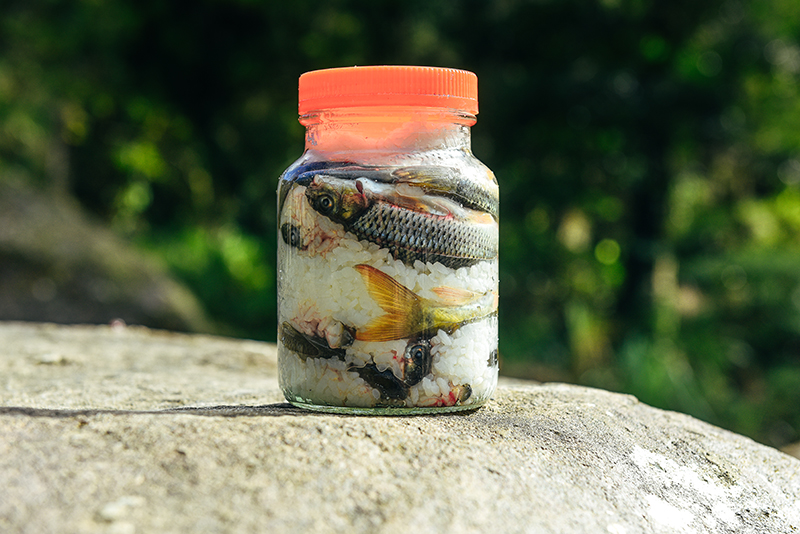
Born to a poor family, Chang Jen-Chieh, the Atayal hunter and founder of Wulai Hunter school, followed his schoolteacher to hunt and fish in the mountains as a child, exchanging his kill for rice and money to help support his family. Now, as an adult, he turns the hunting and survival skills he has acquired since childhood into curriculum knowledge to pass it on to a wide range of people.

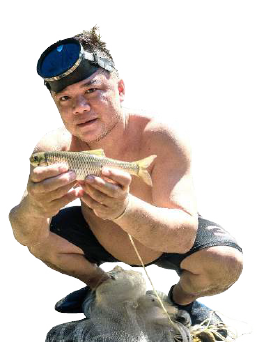
We follow Chang on a hunting trip driving upstream along Wulai's Nanshih River in his “Lamborghini” light truck loaded with fishing tools like fishnets, spears, and fish baskets, along with rice and salt for preserving the catch. Along the way, he’d stop periodically and get off to check the movement of fish in the stream. Despite the distance of dozens of meters between us and the stream, his observation is not any less acute. “Fish are running upstream. Let’s go after them!” he says in a casual tone. Then we jump into the truck again and drive off into the depth of the mountains.
After about 80 minutes of drive from Wulai’s old streets, we arrive at the upper reaches of the Nanshih River at the junction of New Taipei City and Yilan County. The riverbank is overgrown with wild plants taller than a person, and upon arriving, Chang takes out a scythe and begins to cut the tall weeds. In a flash, a path leading to the stream is opened. After unloading the equipment, he walks into the water carrying the cast net. With a twist of the waist, the net is thrown and spread into a perfect circle in the air. As it is pulled in, we see various kinds of fish struggling inside of it, including Taiwan shovel jaw carps (Onychostoma barbatulum), Taiwan torrent carps (Acrossocheilus paradoxus), Taiwan freshwater minnow (Opsariichthys pachycephalus), and Formosan stripe daces (Candidia barbata). While everyone cannot help but exclaim with amazement, he simply blurts out, ”the water is freezing cold in winter!”
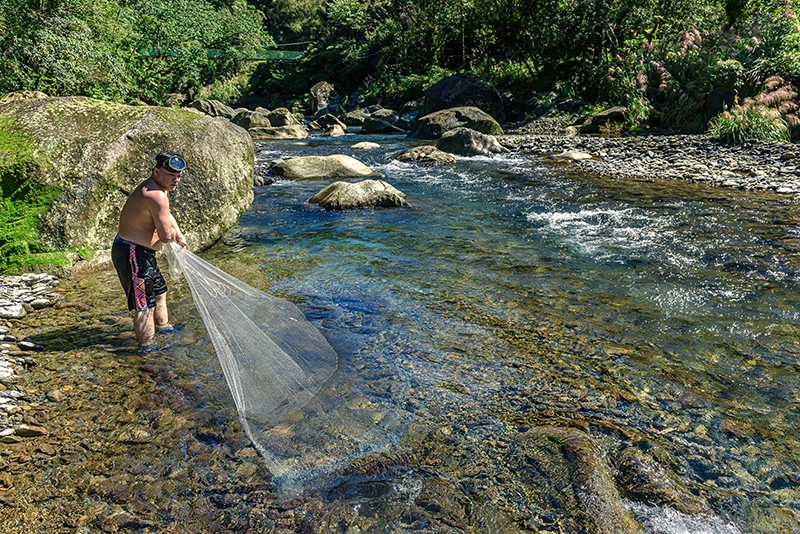
The Atayal hunter Chang Jen-Chieh is fishing at the upper reaches of the Nanshih River.
Mastering Hunting Skills for the Sake of Survival
Born and raised in the Tampya Community of the Atayal people, Chang was recognized as a qualified hunter at the age of 23. Although he once left home to study at the military academy after graduating from high school, he never forgets the hunting and fishing skills he has acquired as a child. “I have to thank my elementary school teacher for his training,” says Chang.
The teacher that Chang mentions was also a hunter from the village. Back in the 1980s, when the trade of wild animals was not officially banned, it was common for schoolchildren to follow their teachers to hunt in the mountains and exchange their prey for rice. The emergence of such practice was due to the fact that in earlier years, schoolteachers were not well-paid, and indigenous people tended to be economically disadvantaged. “We could make money each time we went hunting with the teacher,” Chang recalls. “If bamboo partridges were caught alive with their feet and wings undamaged, they could be sold at 50 NTD for each on the Wulai’s old streets. That’d be enough to support us for a week if we tighten our belts. In the case when the meat begins to spoil or turn rancid, we’d make it into pickles. And since skinny kids like us weren’t strong enough, it took 3 to 4 of us to drag a dead goat together, which was really tiring,” Chang says laughingly.
In addition to wild animals, high-value catch from rivers, such as marbled eels, Taiwan shovel jaw carps, Taiwan torrent carps, and shrimps, can also be traded as commodities. The unsold catch would be preserved in the form of pickles. After years of training by his teacher, Chang has had no difficulty in hunting and fishing. The skills required of a hunter have been internalized as an essential part of his being. “As a child, I didn’t know how to make money. It was my teacher who taught me how to survive as a hunter. These skills were essential for poor kids like us who lived from hand to mouth, never knowing where the next meal was coming from.” He continues, “Had it not been for him, I’d be a doctor or lawyer now.”
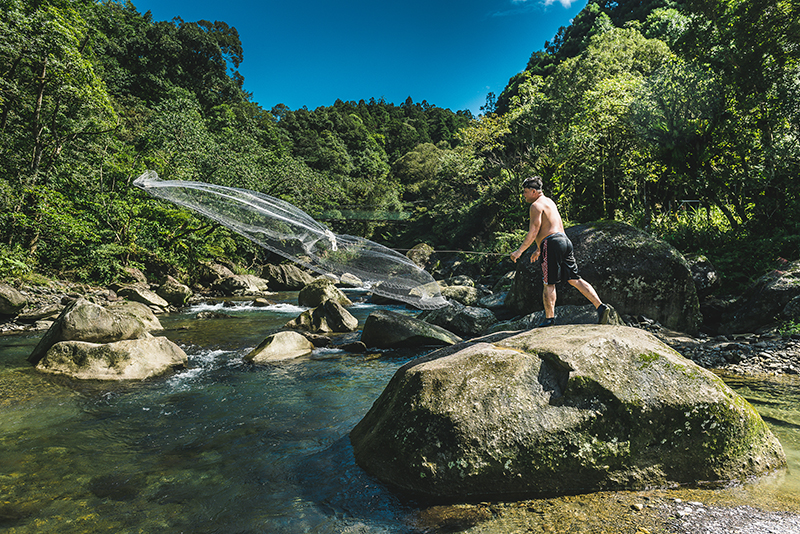
Skilled at throwing a cast net, Chang never fails to spread the net into a perfect circle in the air.
Founding a Hunter School to Impart Survival Skills
Chang left home in his late teens to study in the military academy. During his ten years of military service, Chang never let go of his hunting expertise despite his frequent transfer at an interval of 2 to 3 years. “I’d say that ‘hunting’ is the very term that has never escaped me throughout my entire life. Wherever I was stationed, be it Kukuan in Taichung, Yilan, or Keelung, I’d go hunting with locals in the wilderness. It’s easy to blend in as long as there’s a bottle of rice wine,” remarks Chang.
Just as wild animals can hardly adapt to urban environments, Chang has always wanted to return to Wulai and settle down. The desire was particularly strong when he found himself like a stranger to his eldest daughter in the first few years after her birth, which intensified his yearning for return. In 2007, Chang finally made it a reality when his daughter was studying in primary school. Having understood the importance of learning about their indigenous culture, he was determined to teach and pass on the traditional Atayal crafts and skills to younger generations. To this end, he took the initiative to contact the local school to discuss incorporating Atayal knowledge into the curriculum. However, despite Chang and the school’s emphasis on preserving indigenous culture, other parents were not on the same page with them.
“Parents want their children to focus on their studies and would not allow them to spend time on things other than schoolwork,” says Chang. He had been trying for years to communicate with other parents to reach common ground, but it wasn’t until he was elected Chair of Parent-Teacher Association that they began to interact more frequently and closely, which slowly opened the gate of cultural learning. In 2015, the Wulai Hunter School was founded, opening its doors to a wide range of students, including non-indigenous children brought by their parents hoping to gain an experience of Atayal hunting culture, and grown-ups who came to learn wilderness survival skills for adventures into the mountains. It was indigenous participants who were the minority. Recruiting the faculty was no problem for Chang. “Finding instructors is pretty easy. Elders and women from the community are the best candidates who can help us come up with various courses.”
Chang’s hunter school features its curriculum with a prime focus on “how to survive in the wild.” This is inspired by his experience of serving as a volunteer fireman and rescuer in Wulai, where he sees many cases of victims either suffering from hungry or getting injured from falling off in mountain accidents. “How do you find alternative routes when the path is disrupted by a landslide? Should you go further into the mountains or move towards a stream? How to feed yourself if you decide not to move? If you’re afraid to take any self-help measures, what you can do is wait for people to find and save you.” Chang remarks seriously that these days, people are fond of getting close to nature, but they fail to pay attention to natural surroundings and lack the knowledge of survival skills. In fact, there are many resources in the forests and mountains that can be used for emergency assistance.
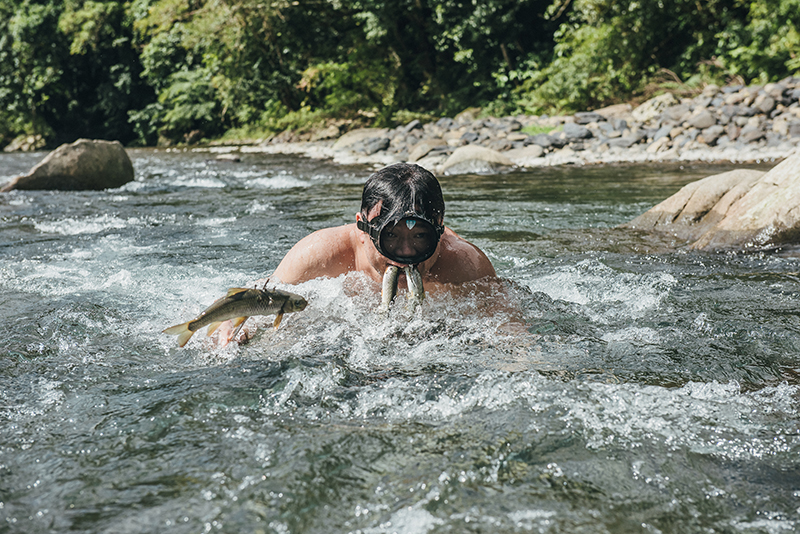
Although spearfishing is highly dangerous, it is most eco-friendly because only large fish are likely to be caught.
Passing On the Spirit of Atayal Hunters
As there are various unknown risks and dangers in the mountains, Chang decides to begin the curriculum with survival training in a river flood scenario. Participants are taught to pay attention to changes in the water. When finding it turning turbid or spotting fallen leaves floating, they must evacuate within less than 30 seconds in case the flood may come in a blink of an eye. In addition, when picking wood for a fire, they should choose those lying on stones, for stones can prevent the wood from moisture due to their lack of absorbency. Once their outer layer is shaved off, you’ll find the inside of the firewood dry enough to make good fuel.
Besides basic knowledge about wilderness survival, Chang also introduces to students the Atayal people’s traditional means of fishing such as the use of cast nets, stone-built fish traps, bare hands, and spears, all of which are used depending on the season or river conditions. Take the cast net for example. It is used when the water turns turbid at its highest or lowest levels. In cases like this, Chang insists that one must be accompanied by a partner. “If a green hand happens to catch driftwood but fails to pull the net back in time to remove it, he might be dragged into the river instead. Then there must be someone nearby to provide timely assistance. On the other hand, when the water level is low, the pair can work hand in hand with one casting stones to attract fish with sounds, while the other waiting for a chance to catch them.”
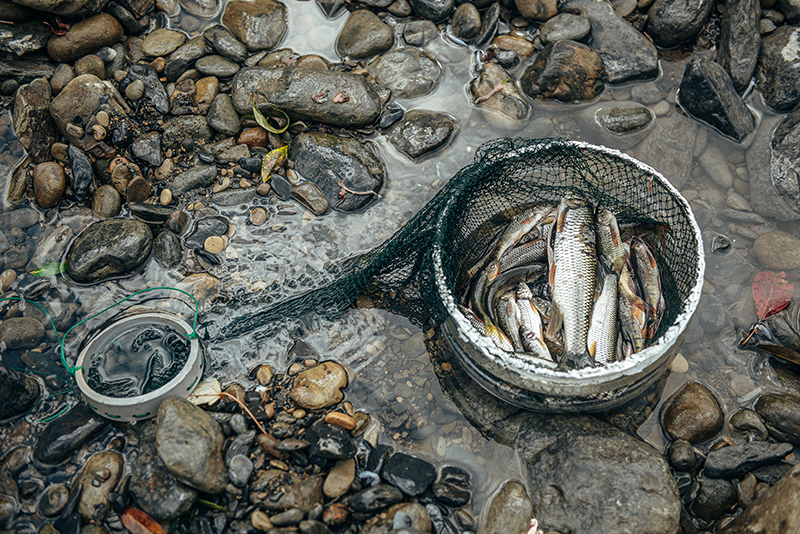
Fish traps are usually set up in summertime by arranging stacks of stones into an inverted V-shape trap. In winter, fishing baskets are placed inside the trap to catch fish swimming upstream to spawn. Once trapped, they simply have no chance to escape. “But this method is cruel, so we place only one basket or two to prevent causing damage to the ecology.” Chang goes on to point out that the most eco-friendly fishing method is using the spear because only large ones are likely to be caught this way. Fishing with bare hands, on the other hand, is for kids and participants from the hunter school as a kind of hands-on experience.
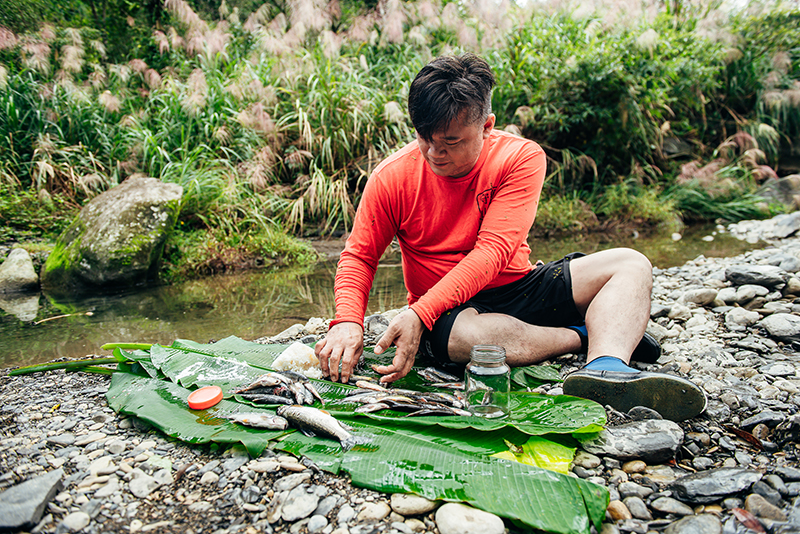
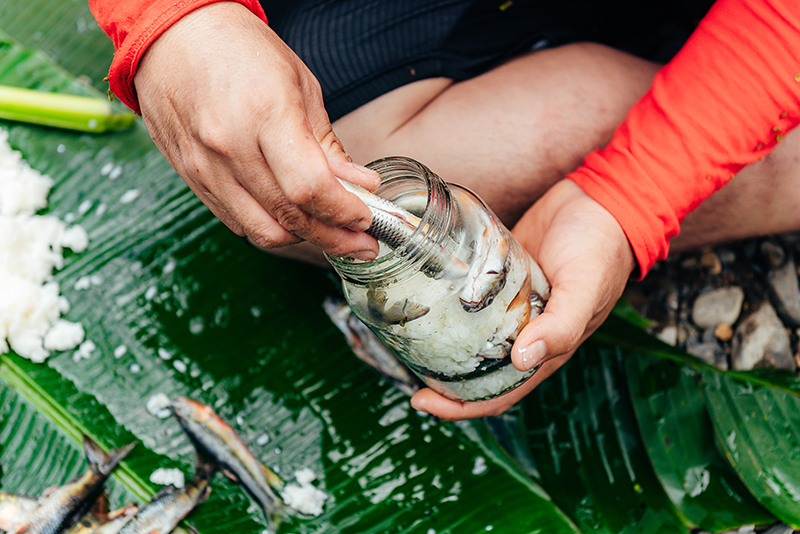
The Atayal people have a unique way of making fish pickles. First, remove the guts of Taiwan shovel-jaw carps. Then rub the fish with salt before stacking them with cold rice layer by layer in a jar. After 15 days of fermentation, the fish pickle is done and ready to eat.
The catch must be processed while fresh by rubbing it with salt, and the Atayal people have a unique way of making fish pickles that emerges in response to the difficulty of food preservation in the old days and to the fact that fish is inedible when it turns stale. Take Taiwan shovel-jaw carps for instance. First, the guts are removed. Then the flesh is rubbed with salt before it is stacked with cold rice layer by layer in a jar. After 15 days of fermentation, the fish pickle is done and ready to eat. This unique way of pickling technique transforms the flavor of fish through fermentation, which not only ensures a longer period of preservation but also elevates the texture and taste to a different level. Unfortunately, due to the popularity of refrigerators, fewer and fewer people keep it a habit to make fish pickles.
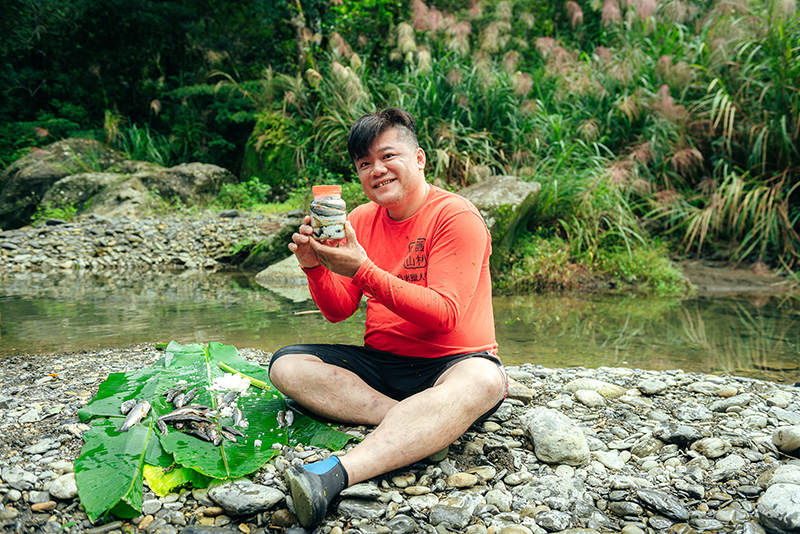
Having perfected the crafts and skills of Atayal culture, now Chang is fully dedicated to his education career and the transmission of traditional knowledge. His aim is not only to impart knowledge about wilderness survival skills but also to familiarize more youngsters with their indigenous culture. “Young people nowadays tend to think they can make good hunters simply with a hunting rifle and a motorcycle. But they neglect the fact that to be a real hunter, one must be able to wait in patience in order to hunt something big.” Chang hopes that as more and more people visit Wulai to get a better understanding of the indigenous culture, the prosperity of tourism industries would create more job opportunities for young people to stay, which in turn will ensure the continuation of Atayal culture and transmission of traditional wisdom.
